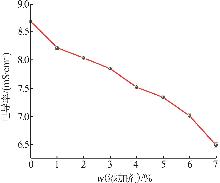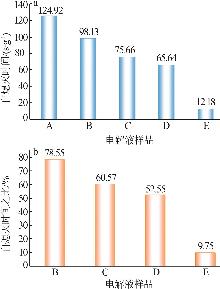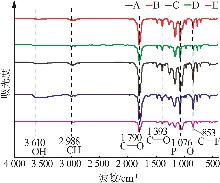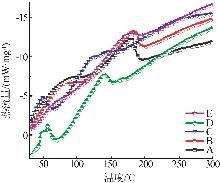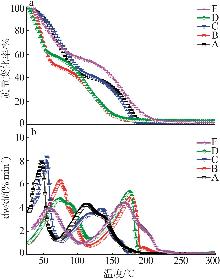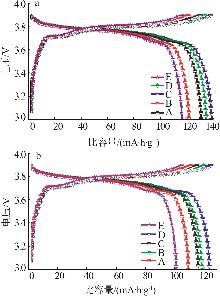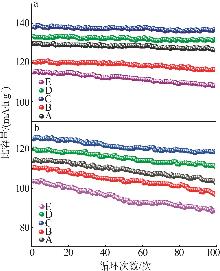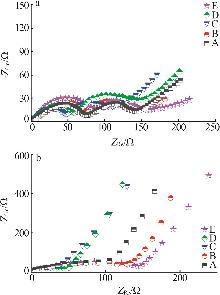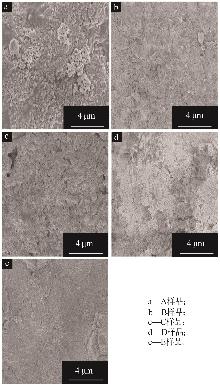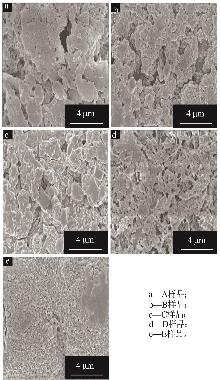Inorganic Chemicals Industry ›› 2025, Vol. 57 ›› Issue (6): 85-92.doi: 10.19964/j.issn.1006-4990.2024-0593
• Research & Development • Previous Articles Next Articles
Study on trimethyl phosphate-mixed salt flame retardant electrolytes performance
WANG Yiren1,2,3( ), DUO Xinghong1,2,3,4(
), DUO Xinghong1,2,3,4( )
)
- 1. School of Chemistry and Material Science,Qinghai Minzu University,Xi′ning 810007,China
2. Qinghai Provincial Key Laboratory of Nanomaterials and Technology,Xi′ning 810007,China
3. Qinghai Provincial Key Laboratory of Applied Physical Chemistry,Xi′ning 810007,China
4. Qinghai Provincial Demonstration Center for Basic Chemistry Experimental Teaching,Xi′ning 810007,China.
-
Received:2024-11-07Online:2025-06-10Published:2025-06-25 -
Contact:DUO Xinghong E-mail:755874970@qq.com;wlkdxh@tju.edu.cn
CLC Number:
Cite this article
WANG Yiren, DUO Xinghong. Study on trimethyl phosphate-mixed salt flame retardant electrolytes performance[J]. Inorganic Chemicals Industry, 2025, 57(6): 85-92.
share this article
| 1 | 杨柯蓉,张晶晶,东红,等.改善锂离子电池电极/电解液界面高温稳定性的研究进展[J].功能材料,2023,54(2):2012-2017. |
| YANG Kerong, ZHANG Jingjing, DONG Hong,et al.Research progress on improving high-temperature stability of electrode/electrolyte interface of lithium-ion batteries[J].Journal of Functional Materials,2023,54(2):2012-2017. | |
| 2 | 彭晨熹,刘军.钠离子电池层状过渡金属氧化物正极材料的研究进展[J].无机盐工业,2023,55(10):1-12,69. |
| PENG Chenxi, LIU Jun.Research progress of layered transition metal oxides cathode materials for sodium-ion batteries[J].Inorganic Chemicals Industry,2023,55(10):1-12,69. | |
| 3 | 常修亮,郑莉莉,韦守李,等.锂离子电池热失控仿真研究进展[J].储能科学与技术,2021,10(6):2191-2199. |
| CHANG Xiuliang, ZHENG Lili, WEI Shouli,et al.Progress in thermal runaway simulation of lithium-ion batteries[J].Energy Storage Science and Technology,2021,10(6):2191-2199. | |
| 4 | LI Xi, LI Weikang, CHEN Lai,et al.Ethoxy(pentafluoro) cyclotriphosphazene(PFPN) as a multi-functional flame retardant electrolyte additive for lithium-ion batteries[J].Journal of Power Sources,2018,378:707-716. |
| 5 | BOLLOJU S, VANGAPALLY N, ELIAS Y,et al.Electrolyte additives for Li-ion batteries:Classification by elements[J].Progress in Materials Science,2025,147:101349. |
| 6 | WINTER E, BRICCOLA M, SCHMIDT T J,et al.Enabling LiNO3 in carbonate electrolytes by flame-retardant electrolyte additive as a cosolvent for enhanced performance of lithium metal batteries[J].Applied Research,2024,3(1):e202200096. |
| 7 | 潘新锋,邵长风,王小燕.车用锂电池热失控特性及其控制方法分析[J].时代汽车,2024(17):145-147. |
| PAN Xinfeng, SHAO Changfeng, WANG Xiaoyan.Analysis of thermal runaway characteristics and control methods of automotive lithium batteries[J].Auto Time,2024(17):145-147. | |
| 8 | 胡广,廖承林,张文杰.车用锂离子电池热失控研究综述[J].电工电能新技术,2021,40(2):66-80. |
| HU Guang, LIAO Chenglin, ZHANG Wenjie.A review on thermal runaway of lithium-ion batteries for electric vehicle[J].Advanced Technology of Electrical Engineering and Energy,2021,40(2):66-80. | |
| 9 | ZHANG Xingyi, SUN Qingwei, ZHEN Cheng,et al.Recent progress in flame-retardant separators for safe lithium-ion batteries[J].Energy Storage Materials,2021,37:628-647. |
| 10 | YANG Binbin, LI Cuihua, ZHOU Junhui,et al.Pyrrolidinium-based ionic liquid electrolyte with organic additive and LiTFSI for high-safety lithium-ion batteries[J].Electrochimica Acta,2014,148:39-45. |
| 11 | 黎可,穆居易,金翼,等.磷酸铁锂电池火灾危险性[J].储能科学与技术,2021,10(3):1177-1186. |
| LI Ke, MU Juyi, JIN Yi,et al.Fire risk of lithium iron phosphate battery[J].Energy Storage Science and Technology,2021,10(3):1177-1186. | |
| 12 | 靳欣,张建茹,王其钰,等.混合固液锂离子电池的热失控行为研究[J].储能科学与技术,2024,13(1):48-56. |
| JIN Xin, ZHANG Jianru, WANG Qiyu,et al.Study on thermal runaway of hybrid solid-liquid batteries[J].Energy Storage Science and Technology,2024,13(1):48-56. | |
| 13 | TOHAMY H S, EL-SAKHAWY M, ELNASHARTY M M M.Carboxymethyl cellulose membranes blended with carbon nanotubes/Ag nanoparticles for eco-friendly safer lithium-ion batteries[J].Diamond and Related Materials,2023,138:110205. |
| 14 | LI Yang, VALLEM S,BAE J.MXene-based composites for high-performance and fire-safe lithium-ion battery[J].Current Applied Physics,2023,53:142-164. |
| 15 | 李存璞,唐晓霞,魏子栋.锂离子电池的热失控与预防[J].科技导报,2024,42(12):178-192. |
| LI Cunpu, TANG Xiaoxia, WEI Zidong.Thermal runaway and prevention of lithium-ion batteries[J].Science & Technology Review,2024,42(12):178-192. | |
| 16 | YAN Peng, ZHU Yucheng, PAN Xuhai,et al.A novel flame-retardant electrolyte additive for safer lithium-ion batteries[J]. In- ternational Journal of Energy Research,2021,45(2):2776- 2784. |
| 17 | SHAHID S, AGELIN-CHAAB M.A review of thermal runaway prevention and mitigation strategies for lithium-ion batteries[J].Energy Conversion and Management:X,2022,16:100310. |
| 18 | 刘焕蓉,邹稼轩,吕源,等.锂离子电池阻燃电解液添加剂研究进展[J].能源研究与利用,2024(1):26-32. |
| LIU Huanrong, ZOU Jiaxuan, Yuan LÜ,et al.Research progress of flame retardant electrolyte additives for lithium ion batteries[J].Energy Research & Utilization,2024(1):26-32. | |
| 19 | QI Shihan, LI Xiu, MA Jianmin.Breakthrough on understanding the solid electrolyte interphase[J].Science Bulletin,2022,67(10):1013-1014. |
| 20 | VU T T, CHEON H J, SHIN S Y,et al.Hybrid electrolytes for solid-state lithium batteries:Challenges,progress,and prospects[J].Energy Storage Materials,2023,61:102876. |
| 21 | YANG Huijun, GUO Cheng, CHEN Jiahang,et al.An intrinsic flame-retardant organic electrolyte for safe lithium-sulfur batteries[J].Angewandte Chemie International Edition,2019,58(3):791-795. |
| 22 | LIN Yilong, HUANG Sheng, ZHONG Lei,et al.Organic liquid electrolytes in Li-S batteries:Actualities and perspectives[J].Energy Storage Materials,2021,34:128-147. |
| 23 | QI Shihan, WANG Huaping, HE Jian,et al.Electrolytes enriched by potassium perfluorinated sulfonates for lithium metal batteri- es[J].Science Bulletin,2021,66(7):685-693. |
| 24 | 何孟雪,李一涛,刘亚涛,等.磷酸酯基阻燃电解液用于高安全锂硫电池[J].工程科学学报,2024,46(4):765-774. |
| HE Mengxue, LI Yitao, LIU Yatao,et al.Nonflammable phosphate electrolytes for high-safety lithium-sulfur batteries[J].Chinese Journal of Engineering,2024,46(4):765-774. | |
| 25 | 王成云,薛晓东,冀红略,等.气质联用法测定锂离子电池电解液中有机磷阻燃剂的含量[J].电池工业,2019,23(4):204-210,215. |
| WANG Chengyun, XUE Xiaodong, JI Honglue,et al.Determination of organophosphate retardants in lithium-ion battery electrolyte by GC/MS method[J].Chinese Battery Industry,2019,23(4):204-210,215. | |
| 26 | 蒋会春,潘旭海,徐大用,等.聚磷酸铵/离子液体复配环氧树脂阻燃剂研究[J].热固性树脂,2023,38(4):21-25. |
| JIANG Huichun, PAN Xuhai, XU Dayong,et al.Study on ammonium polyphosphate/ionic liquid compound epoxy resin flame retardant[J]. Resin Thermosetting,2023,38(4):21-25. | |
| 27 | WU Minghong, HAN Shiheng, LIU Shumei,et al.Fire-safe polymer electrolyte strategies for lithium batteries[J].Energy Storage Materials,2024,66:103174. |
| 28 | 石敏,蒋鹏杰,徐琛,等.抑制锂金属负极枝晶的电解液调控策略[J].储能科学与技术,2024,13(5):1620-1634. |
| SHI Min, JIANG Pengjie, XU Chen,et al.Advancements in electrolyte optimization strategies for inhibiting lithium dendrite growth[J].Energy Storage Science and Technology,2024,13(5):1620-1634. | |
| 29 | WANG Junling, CAI Wei, MU Xiaowei,et al.Construction of multifunctional and flame retardant separator towards stable lithium-sulfur batteries with high safety[J].Chemical Engineering Journal,2021,416:129087. |
| 30 | DONG Xinxin, ZHU Tao, LIU Guoqing,et al.Brominated flame retardants coated separators for high-safety lithium-sulfur batteries[J].Journal of Colloid and Interface Science,2023,643:223- 231. |
| 31 | DEYSHER G, OH J A S, CHEN Yuting,et al.Design principles for enabling an anode-free sodium all-solid-state battery[J].Nature Energy,2024,9:1161-1172. |
| 32 | 曾子琪,艾新平,杨汉西,等.有机磷酸酯阻燃电解液的研究进展[J].电化学,2020,26(5):683-693. |
| ZENG Ziqi, AI Xinping, YANG Hanxi,et al.Research progress of high-safety phosphorus-based electrolyte[J].Journal of Electrochemistry,2020,26(5):683-693. |
| [1] | CHEN Guanyi, XU Junwei. Hydrothermal synthesis of tin-based perovskite and study on high-temperature crystalline phase transition and surface active sites [J]. Inorganic Chemicals Industry, 2025, 57(4): 37-44. |
| [2] | YE Bin, XU Shun, HUANG Hua. Simulation study on thermal runaway of lithium-ion battery modules in high temperature environments [J]. Inorganic Chemicals Industry, 2025, 57(4): 52-59. |
| [3] | MA Jingyuan, LI Yan, ZHOU Hanjie, LI Jiangang. Research progress of PEO based organic/inorganic composite solid electrolyte [J]. Inorganic Chemicals Industry, 2025, 57(3): 1-8. |
| [4] | CHEN Xue, JIANG Guanghui, OUYANG Quansheng, SHAO Jiaojing. Recent research progress of lithium sulfur batteries under lean electrolyte based on sulfur electrode design [J]. Inorganic Chemicals Industry, 2025, 57(2): 1-13. |
| [5] | ZHANG Shanshan, ZENG Yule, ZHANG Ting, LIN Sen, LIU Chenglin. Research progress of cathode pre-lithiation technology for lithium-ion batteries [J]. Inorganic Chemicals Industry, 2025, 57(1): 1-13. |
| [6] | TIAN Peng, ZHANG Haoran, XU Jingang, MOU Chenxi, XU Qianjin, NING Guiling. Study on aluminum sol modified anode and cathode materials for lithium ion batteries [J]. Inorganic Chemicals Industry, 2024, 56(9): 44-53. |
| [7] | CHEN Xue, OUYANG Quansheng, SHAO Jiaojing. Recent research progress of lithium-sulfur batteries based on solid-solid reaction mechanism [J]. Inorganic Chemicals Industry, 2024, 56(9): 12-23. |
| [8] | ZHU Zongjiang, WANG Gang, WEI Yuanfeng, TANG Yanhong, KAKUTA Cheng, LIU Chengbin. Research progress and prospect of resourceful recycling technology of electrolyte from decommissioned lithium⁃ion battery [J]. Inorganic Chemicals Industry, 2024, 56(7): 11-17. |
| [9] | ZHANG Bangcheng, WANG Li. Preparation and adsorption properties of waste polyester⁃based activated carbon activated by ZnCl2 [J]. Inorganic Chemicals Industry, 2024, 56(7): 126-134. |
| [10] | LIU Jie, SHI Xueru, WEI Shubing, CAO Xinxin. Artificial interface layer construction and sodium storage performance of P2-type layered oxide cathode [J]. Inorganic Chemicals Industry, 2024, 56(3): 39-44. |
| [11] | LI Yaguang, HAN Dongzhan, QI Lijuan. Recent research on pretreatment of waste lithium-ion batteries and electrolyte recovery technology [J]. Inorganic Chemicals Industry, 2024, 56(2): 1-10. |
| [12] | WAN Feng, YAN Yingchun, FAN Zhuangjun. Research progress and prospect of halide solid electrolytes [J]. Inorganic Chemicals Industry, 2024, 56(11): 15-29. |
| [13] | LIU Juan, JIANG Qinglai, ZHANG Yueyi. Study on Al-Zn co-doping of 4.6 V high voltage lithium cobalt oxide cathode materials [J]. Inorganic Chemicals Industry, 2024, 56(11): 59-64. |
| [14] | XU Xijun, LIN Jianfeng, LUO Xiongwei, ZHAO Jingwei, HUO Yanping. Recent progress of NASICON-type Na1+x Zr2Si x P3-x O12 solid electrolyte for sodium metal batteries [J]. Inorganic Chemicals Industry, 2024, 56(11): 1-14. |
| [15] | QIN Ye, LIU Chang, HAN Song, WANG Shuo. Study on conductivity of electrolyte in aqueous Zn-Mn battery [J]. Inorganic Chemicals Industry, 2024, 56(11): 132-138. |
| Viewed | ||||||
|
Full text |
|
|||||
|
Abstract |
|
|||||
|
||
